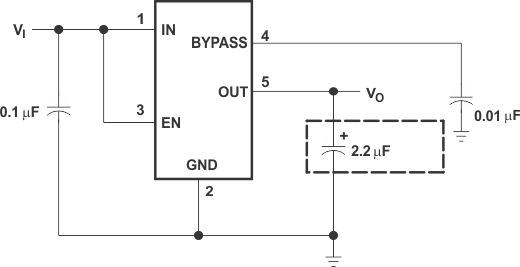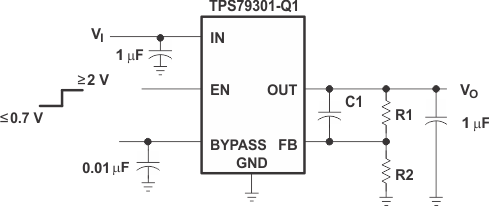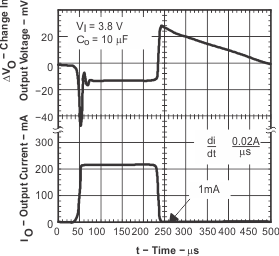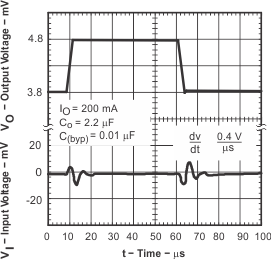SGLS162I April 2003 – March 2016 TPS793-Q1
PRODUCTION DATA.
- 1 Features
- 2 Applications
- 3 Description
- 4 Revision History
- 5 Voltage Options
- 6 Pin Configuration and Functions
- 7 Specifications
- 8 Detailed Description
- 9 Application and Implementation
- 10Power Supply Recommendations
- 11Layout
- 12Device and Documentation Support
- 13Mechanical, Packaging, and Orderable Information
Package Options
Mechanical Data (Package|Pins)
Thermal pad, mechanical data (Package|Pins)
Orderable Information
9 Application and Implementation
NOTE
Information in the following applications sections is not part of the TI component specification, and TI does not warrant its accuracy or completeness. TI’s customers are responsible for determining suitability of components for their purposes. Customers should validate and test their design implementation to confirm system functionality.
9.1 Application Information
The TPS793xx-Q1 family of low-dropout (LDO) regulators has been optimized for use in noise-sensitive battery-operated equipment. The device features extremely low dropout voltages, high PSRR, ultralow output noise, low quiescent current (170 μA typically), and enable-input to reduce supply currents to less than 1 μA when the regulator is turned off.
9.2 Typical Application
A typical application circuit is shown in Figure 24.
 Figure 24. Typical Application Circuit
Figure 24. Typical Application Circuit
9.2.1 Design Requirements
Table 2 lists the design requirements.
Table 2. Design Parameters
| PARAMETER | DESIGN REQUIREMENTS |
|---|---|
| Input voltage | 3 V – 4 V (Lithium Ion battery) |
| Output voltage | 2.8 V |
| DC output current | 10 mA |
| Peak output current | 75 mA |
| Maximum ambient temperature | 65°C |
9.2.2 Detailed Design Procedure
9.2.2.1 External Capacitor Requirements
A 0.1-μF or larger ceramic input bypass capacitor, connected between IN and GND and located close to the TPS793xx-Q1, is required for stability and improves transient response, noise rejection, and ripple rejection. A higher-value electrolytic input capacitor may be necessary if large, fast-rise-time load transients are anticipated and the device is located several inches from the power source.
Like all LDOs, the TPS793xx-Q1 requires an output capacitor connected between OUT and GND to stabilize the internal control loop. The minimum recommended capacitance is 2.2-μF. Any 2.2-μF or larger ceramic capacitor is suitable, provided the capacitance does not vary significantly over temperature.
The internal voltage reference is a key source of noise in an LDO regulator. The TPS793xx-Q1 has a BYPASS pin that is connected to the voltage reference through a 250-kΩ internal resistor. The 250-kΩ internal resistor, in conjunction with an external bypass capacitor connected to the BYPASS pin, creates a low pass filter to reduce the voltage reference noise and, therefore, the noise at the regulator output. For the regulator to operate properly, the current flow out of the BYPASS pin must be at a minimum, because any leakage current creates an IR drop across the internal resistor, thus, creating an output error. Therefore, the bypass capacitor must have minimal leakage current.
For example, the TPS79328-Q1 exhibits only 32 μVRMS of output voltage noise using a 0.1-μF ceramic bypass capacitor and a 2.2-μF ceramic output capacitor. Note that the output starts up slower as the bypass capacitance increases due to the RC time constant at the BYPASS pin that is created by the internal 250-kΩ resistor and external capacitor.
9.2.2.2 Programming the TPS79301-Q1 Adjustable LDO Regulator
The output voltage of the TPS79301-Q1 adjustable regulator is programmed using an external resistor divider as shown in Figure 25. The output voltage is calculated using Equation 1.

where
Resistors R1 and R2 should be chosen for approximately 50-μA divider current. Lower-value resistors can be used for improved noise performance, but the solution consumes more power. Higher resistor values should be avoided as leakage current into/out of FB across R1/R2 creates an offset voltage that artificially increases/decreases the feedback voltage and, thus, erroneously decreases or increases VO. The recommended design procedure is to choose R2 = 30.1 kΩ to set the divider current at 50 μA, C1 = 15 pF for stability, and then calculate R1 using Equation 2.

To improve the stability of the adjustable version, TI suggests placing a small compensation capacitor between OUT and FB. For voltages <1.8 V, the value of this capacitor should be 100 pF. For voltages >1.8 V, the approximate value of this capacitor can be calculated using Equation 3.

The suggested value of this capacitor for several resistor ratios is shown in the table in Table 3. If this capacitor is not used (such as in a unity-gain configuration) or if an output voltage <1.8 V is chosen, then the minimum recommended output capacitor is 4.7 μF instead of 2.2 μF.
 Figure 25. TPS79301-Q1 Adjustable LDO Regulator Programming
Figure 25. TPS79301-Q1 Adjustable LDO Regulator Programming
Table 3. Output Voltage Programming Guide
| OUTPUT VOLTAGE | R1 | R2 | C1 |
|---|---|---|---|
| 2.5 V | 31.6 kΩ | 30.1 kΩ | 22 pF |
| 3.3 V | 51 kΩ | 30.1 kΩ | 15 pF |
| 3.6 V | 59 kΩ | 30.1 kΩ | 15 pF |
9.2.3 Application Curves

